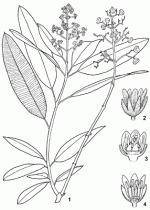
Record display
 PROTA4U Homepage
PROTA4U Homepage Select translation pop-up: Select translation pop-up: |
 |
PROTA4U Record display |
 PROTA4U Homepage PROTA4U Homepage
|
| Ann. Sci. Nat., sér. 2, 20: 91, t. 1, f. 3 (1843). | |||
| show more data (25) | comments (0) |
| Anacardiaceae | |||
| show more data (22) | comments (0) |
| Heeria insignis (Delile) Kuntze (1891), Heeria reticulata (Baker f.) Engl. (1906), Ozoroa reticulata (Baker f.) R.Fern. & A.Fern. (1965). | |||
| show more data (50) | comments (0) |
| Tropical resin tree, currant resin tree (En). Mwalika, mzabibu mwitu (Sw). | |||
| show more data (31) | comments (0) |
| Ozoroa insignis is widespread throughout tropical sub-Saharan Africa, from Senegal east to Eritrea and Yemen, and south to Namibia. It also occurs in South Africa and Swaziland. | |||
| show more data (58) | comments (0) |
| The wood of Ozoroa insignis is used in carving and for poles, but is mainly used as firewood and to make charcoal. The charcoal is of very good quality and can even be used in making gunpowder. The fruits are occasionally eaten and are also ground up and used by Zulu women to scent their hair. In Kenya, a decoction of the root and bark is used to treat kidney and liver complaints, chest pain and diarrhoea, and in Zimbabwe to treat schistosomiasis. In several parts of Africa, roots and bark are used as a vermifuge. In Mali roots are used in the treatment of ulcers and hernias, leaves to treat otitis, colics and dysentery, muscle pains and fever, while decoctions of leafy branches are applied after childbirth and to treat hypertension. The bark is used in Sudan to treat throat infections. In Mali, tooth sticks made of the wood of Ozoroa insignis are considered an infallible talisman to attract women. | |||
| show more data (27) | comments (0) |
| The wood of Ozoroa insignis is red in colour and hard, tough and durable, but easy to work. It is resistant to termites. Extracts of the bark and roots have been shown to be lethal to schistosomes which cause urinary schistosomiasis. The results from tests with hamsters infected with Schistosoma haematobium cercariae suggested that crude extracts of Ozoroa insignis administered orally are lethal to adult schistosomes. Screening of extracts in Zimbabwe revealed that root bark and leaves gave the best results against tapeworms. Air dried twigs collected in Kenya contained a bioactive compound, 6-pentadecylsalicylic acid, toxic to brine shrimp (Artemia salina) larvae. | |||
| show more data (2) | comments (0) |
| Dioecious, much-branched shrub or small to medium-sized tree up to 15 m tall, with milky sap; bole cylindrical, sometimes tortuous, up to 50 cm in diameter; bark grey, corky, much fissured, slash reddish; branchlets puberulous to yellowish villous. Leaves alternate or in subverticils of 3, simple; stipules absent; petiole (1–)1.5–3(–5) cm long, subterete, slightly grooved above, densely villous to puberulous; lamina variable in shape, generally oblong to lanceolate or oblong-elliptical, (5.5–)7–22(–27.5) cm × 2–8.5 cm, coriaceous or subcoriaceous, base rounded or cuneate, apex obtuse or acute and mucronate, entire, lateral veins closely parallel, upper surface glabrous or puberulous to villous only on the veins, lower surface usually densely hairy. Inflorescence a terminal or axillary, much-branched panicle, up to 17 cm long; bracts subulate, 3–4(–10) mm long. Flowers unisexual, 5-merous; pedicel 1–1.5 mm long, articulated near apex; sepals ovate to ovate-triangular, 1.5–3.7 mm × 0.7–1.5 mm, acute, dorsally appressed-villous; petals oblong, 2–4 mm × 1–2 mm, whitish to yellowish, apex obtuse, flat, dorsally appressed pilose or villous; male flowers with 5 stamens having subulate filaments and linear-oblong to ovate, dorsifixed anthers, ovary vestigial; female flowers with superior, compressed-globose, unilocular ovary having 3 styles and capitate stigmas, staminodes small. Fruit a transversally ellipsoid, compressed drupe 6–8 mm × 8–11 mm, initially red, turning black and shiny. | |||
| show more data (10) | comments (0) |
| Ozoroa comprises about 40 species, most of which occur in southern Africa. The species are often difficult to distinguish from each other. Ozoroa insignis is in section Ozoroa, which comprises tree and shrub-like species with petioles longer than 5 mm, rather broad terminal panicles and petals which are flat or concave when fully developed. Ozoroa insignis is subdivided into 3 subspecies: subsp. insignis with narrow leaves covered beneath with appressed silvery hairs, occurring from West Africa to Ethiopia, Somalia and Yemen; subsp. latifolia (Engl.) R.Fern. & A.Fern. with broader leaves covered beneath with appressed hairs, occurring in coastal areas from Senegal to Angola; and subsp. reticulata (Oliv.) J.B.Gillett with broader leaves covered beneath with short appressed as well as long spreading hairs, occurring from southern Sudan and Kenya to South Africa. Intermediates between the subspecies and also between Ozoroa insignis and Ozoroa obovata (Oliv.) R.Fern. & A.Fern. have been recorded from different regions. More taxonomic studies on the delimitation of Ozoroa insignis are needed. | |||
| show more data (6) | comments (0) |
| show more data (1) | comments (0) |
| Ozoroa insignis occurs in wooded grassland and open forest, extending into drier forest and deciduous forest in areas of higher rainfall, often on scarps, denuded soils and rocky slopes. It occurs from sea level to 2200 m altitude. | |||
| show more data (17) | comments (0) |
| Ozoroa insignis can be propagated by seed or root suckers. The weight of 1000 seeds is about 25 g. Germination is generally good and takes 3 weeks. Seed cannot be stored as it loses viability in a few weeks. | |||
| show more data (4) | comments (0) |
| show more data (1) | comments (0) |
| Ozoroa insignis can be coppiced, but information on regrowth is not available. | |||
| show more data (0) | comments (0) |
| The risk of genetic erosion is considered small given the common occurrence and very wide distribution of Ozoroa insignis. | |||
| show more data (0) | comments (0) |
| It is likely that the wood of Ozoroa insignis will continue to be used for fuel and charcoal production. However, there are no indications that it will become a component of forest plantations for fuel or timber. | |||
| show more data (0) | comments (0) |
| • Arbonnier, M., 2000. Arbres, arbustes et lianes des zones sèches d’Afrique de l’Ouest. CIRAD, MNHN, UICN. 541 pp. • Bein, E., Habte, B., Jaber, A., Birnie, A. & Tengnäs, B., 1996. Useful trees and shrubs in Eritrea: identification, propagation and management for agricultural and pastoral communities. Technical Handbook No 12. Regional Soil Conservation Unit, Nairobi, Kenya. 422 pp. • Coates Palgrave, K., 1983. Trees of southern Africa. 2nd Edition. Struik Publishers, Cape Town, South Africa. 959 pp. • Gilbert, M.G., 1989. Anacardiaceae (including Pistaciaceae). In: Hedberg, I. & Edwards, S. (Editors). Flora of Ethiopia. Volume 3. Pittosporaceae to Araliaceae. The National Herbarium, Addis Ababa University, Addis Ababa, Ethiopia and Department of Systematic Botany, Uppsala University, Uppsala, Sweden. pp. 513–532. • He WeiDong, van Puyvelde, L., Bosselaers, J., de Kimpe, N., van der Flaas, M., Roymans, A., Mathenge, S.G., Mudida, F.P. & Motiso, P.B.C., 2000. Bioactive principles from plants of Kenya. IV. Study on the antifouling activity of Ozoroa insignis Del. Mededelingen Faculteit Landbouwkundige en Toegepaste Biologische Wetenschappen, Universiteit Gent 65(4): 29–33. • Johns, T., Faubert, G.M., Kokwaro, J.O., Mahunnah, R.L.A. & Kimanani, E.K., 1995. Anti-giardial activity of gastrointestinal remedies of the Luo of East Africa. Journal of Ethnopharmacology 46: 17–23. • Kokwaro, J.O., 1986. Anacardiaceae. In: Polhill, R.M. (Editor), 1986. Flora of Tropical East Africa. A.A. Balkema, Rotterdam, Netherlands. 59 pp. • Mølgaard, P., Nielsen, S.B., Rasmussen, D.E., Drummond, R.B., Makaza, N. & Andreassen, J., 2001. Anthelmintic screening of Zimbabwean plants traditionally used against schistosomiasis. Journal of Ethnopharmacology 74: 257–264. • Ndamba, J., Nyazema, N., Makaza, N., Anderson, C. & Kaondera, K.C., 1994. Traditional herbal remedies used for the treatment of urinary schistosomiasis in Zimbabwe. Journal of Ethnopharmacology 42: 125–132. • Palmer, E. & Pitman, N., 1972–1974. Trees of southern Africa, covering all known indigenous species in the Republic of South Africa, South-West Africa, Botswana, Lesotho and Swaziland. 3 volumes. Balkema, Cape Town, South Africa. 2235 pp. | |||
| show more data (44) | comments (0) |
| • Ayedoun, M.A., Moudachirou, M., Garneau, F.X., Gagnon, H., Jean, F.I., Tomi, F. & Cassanova, J., 1998. Constituents of the leaf and flower oils of Heeria insignis Del. from Benin. Journal of Essential Oil Research 10: 529–539. • Fernandes, R.B., 1966. Estudos nas Anacardiaceae Africanas. 1 - Contribuição para o conhecimento do género Ozoroa Del. Garcia de Orta, Revista da Junta de Investigações do Ultramar 14: 19–60. • Ichikawa, N., undated. Ozoroa reticulata. [Internet] Database Aflora. Center for African Area Studies, Kyoto University, Kyoto, Japan. http://jambo.africa.kyoto-u.ac.jp. Accessed January 2002. • Kokwaro, J.O. & Gillett, J.B., 1980. Notes on the Anacardiaceae of Eastern Africa. Kew Bulletin 34: 745–760. • Malgras, R.P.D., 1992. Arbres et arbustes guérisseurs des savanes maliennes. A.C.C.T. & Éditions Karthala, Paris, France. 478 pp. • van der Veken, P., 1960. Anacardiaceae. In: Robyns, W., Staner, P., Demaret, F., Germain, R., Gilbert, G., Hauman, L., Homès, M., Jurion, F., Lebrun, J., Vanden Abeele, M. & Boutique, R. (Editors). Flore du Congo belge et du Ruanda-Urundi. Spermatophytes. Volume 9. Institut National pour l’Étude Agronomique du Congo belge, Brussels, Belgium. pp. 5–108. | |||
| show more data (6) | comments (0) |
| • Gilbert, M.G., 1989. Anacardiaceae (including Pistaciaceae). In: Hedberg, I. & Edwards, S. (Editors). Flora of Ethiopia. Volume 3. Pittosporaceae to Araliaceae. The National Herbarium, Addis Ababa University, Addis Ababa, Ethiopia and Department of Systematic Botany, Uppsala University, Uppsala, Sweden. pp. 513–532. • Kokwaro, J.O., 1986. Anacardiaceae. In: Polhill, R.M. (Editor), 1986. Flora of Tropical East Africa. A.A. Balkema, Rotterdam, Netherlands. 59 pp. | |||
| show more data (0) | comments (0) |
| |||||
| |||||||
| |||||||||
| Oyen, L.P.A., 2002. Ozoroa insignis Delile. [Internet] Record from PROTA4U. Oyen, L.P.A. & Lemmens, R.H.M.J. (Editors). PROTA (Plant Resources of Tropical Africa / Ressources végétales de l’Afrique tropicale), Wageningen, Netherlands. <http://www.prota4u.org/search.asp>. Accessed . | |||
| There are 3 study abstracts related to Ozoroa insignis Delile. Click on "show more" to view them. | ||
| show more data | comments (0) |
| There are 271 book citations related to Ozoroa insignis Delile. Click on "show more" to view them. | ||
| show more data | comments (0) |
| There are 343 citation in web searches related to Ozoroa insignis Delile. Click on "show more" to view them. | ||
| show more data | comments (0) |
| There are 180 citation in scholarly articles related to Ozoroa insignis Delile. Click on "show more" to view them. | ||
| show more data | comments (0) |
| There are 33 citations in Afrirefs related to Ozoroa insignis Delile. Click on "show more" to view them. | ||
| show more data | comments (0) |
| There are 2 Wikipedia citations related to Ozoroa insignis Delile. Click on "show more" to view them. | ||
| show more data | comments (0) |
| General importance |  |
| Geographic coverage Africa |  |
| Geographic coverage World |  |
| Ornamental use |  |
| Forage/feed use |  |
| Fruit use |  |
| Timber use |  |
| Fuel use |  |
| Medicinal use |  |
| Essential oil and exudate use |  |
| Food security |  |

